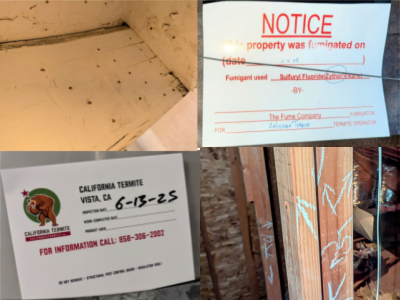Clues Not Always Considered During a Termite Inspection
Let’s face it—many termite inspectors are focused on one thing: selling you a treatment. If they see wood damage, they’ll often claim it’s active termites without considering other explanations. They ignore signs that might tell a different story.
Maybe they started their careers with good intentions. But when they’re constantly being measured on close ratios and average sales, what do you expect? At most of the companies I worked for, inspectors were made well aware of how much each lead cost the company. Do you think anyone in management cared whether the homeowner actually had termites? Probably not. In fact, I’d say the moment a company starts referring to homeowners as “prospects,” it’s time to hide your wallet.
 Here are a few things suspect inspectors often overlook—or choose to ignore:
Here are a few things suspect inspectors often overlook—or choose to ignore:
Fumigation Tags
If a home was fumigated within the last five years, inspectors should know they may still see kickouts or termite droppings, but any major wood damage likely happened before the fumigation.
I was recently in an attic of a home that had been fumigated four years earlier. There were multiple piles of droppings—and no masking agent. That means one of two things: either the fumigation failed (unlikely), or the company never came back to clean up the old evidence (more likely).
What I didn’t do was raise my arms in celebration at the opportunity to sell a comprehensive treatment. Instead, I asked the homeowner some follow-up questions:
- What led to the fumigation?
- Was there swarming at the time?
- Has there been any swarming since?
- Did the company ever return to clean up or mask the droppings?
Turns out, they hadn’t. I recommended masking the old evidence and performing a borate preventative treatment and included a full-structure warranty. The price? Less than what most companies would charge for a single spot treatment with a limited warranty.
Any major damage was the result of what led to the fumigation—not a sign of new activity. Suggesting otherwise is, at best, opportunistic.
One more note: most companies offer a two-year full-structure warranty, but how many actually return for the follow-up? My warranties include annual inspections. If a company never came back, then either their warranty wasn’t as good—or they didn’t hold up their end of the deal.
Inspection Tags
These tags include lines for “Work Completion Date” and “Product Used.” If a treatment was performed in the last few years, it’s reasonable to assume much of the visible damage has already been addressed.
If I see “Tim-bor” or “Bora-Care” listed and there’s no current termite activity in the attic, I won’t try to sell another borate treatment. A properly applied borate treatment can last indefinitely.
Drill Holes
I inspected a home where the owners had moved in six years earlier. They told me it was treated before they bought it. A previous inspector had marked some rafter tails and outriggers as “infested.”
When I looked closer, I saw drill holes—clear signs the wood had already been locally treated. Instead of pushing for a tenting like the other inspector, I spot treated two areas (without drill holes) and provided a one-year full-structure warranty.
If questioned, most inspectors would say, “It doesn’t matter if it was treated—we can’t warranty it unless we do it ourselves.” But if the drill holes are done properly and I see “Termidor” on the inspection tag, I know the treatment was legitimate—and I’m not going to sell the customer something they don’t need.
Patched Sidewalk Holes
If I see dime-sized cement patches around the home’s perimeter, I know a subterranean soil treatment has already been done. I’ll ask the homeowner when it was completed.
According to manufacturers, these chemicals can remain effective in the soil for up to eight years.
Unfortunately, many inspectors—especially from the big companies—try to sell new soil treatments based not on active evidence, but on “conditions conducive,” like:
- Planters near the home
- Improper drainage or grading
- Cellulose debris
They conveniently ignore the patches because asking about them might cost them a sale. They don’t want to know when the treatment was done—they just want to sell you a new one.
(Be very wary of any inspector who recommends treatment based solely on conducive conditions.)
Chalk Marks
Inspectors often use chalk to mark infestations:
- K stands for drywood termites
- S stands for subterranean
If I see an “S” in a crawlspace along with a date, I ask the homeowner if they recall paying for a treatment in that area. These markings are clues—not just instructions for technicians, but a history to be interpreted with context.
Final Advice to Homeowners
Keep good records. You’re not going to remember what was done five or ten years ago.
And always make sure the company performing the treatment masks or removes old termite evidence when the job is complete. Why? Because many inspectors will use that leftover evidence to convince you that you need another treatment.
Don’t assume the inspector has your best interests in mind. If they’re not looking at the full picture, you might end up paying for redundant treatments you don’t need.
John Gelhard


